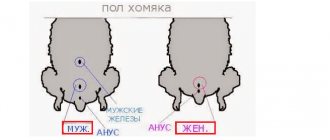Behavior before impending birth
Gestation in dogs is about 63 days.
Throughout pregnancy, the behavior of most dogs remains unchanged. Changes in behavior begin to appear in the last week. The main change is the desire to arrange a “nest”. The animal lies down on the floor, begins to scratch it, and turns over the bedding. Some dogs build a “nest” on the street, but do not hide from humans. Animals begin to hide tidbits that previously would have been eaten immediately. They become distrustful and irritable. They show aggression even towards people they know well and limit their social circle. They strive to defend their territory. They become emotionally unstable, so during this period it is advisable to exclude their communication with children. Some dogs begin to show interest in soft toys that look like small puppies. They react to the squeaking and crying of small children.
Significant changes in the behavior of dogs occur immediately before birth - within a day or two. First of all, before giving birth, a dog almost never remains in its usual place, which reveals atavistic properties inherited from the wolf. In addition, this is due to the division of the habitat into zones - a place for eating, a place for whelping, and a “nest”.
As the time of birth approaches, the dog begins to show anxiety. She constantly gets up from her bed, walks back and forth, lies down, gets up again, asks to go outside. The dog is nervous, worried, looking under its tail. Changes his location all the time. During contractions, the dog's muzzle takes on a rather unusual expression: the dog's gaze is motionless and concentrated on a nearby object. The tail is held in a peculiar way: individuals with a straight and long tail stretch it straight back, and the tip hangs down in some unusual way.
If signs of imminent birth appear, the animal must be placed in the place where the birth will take place and not be left alone.
Signs of impending birth in dogs
- Before giving birth, she will be nervous and make a “nest”
- the dog will try to stay close to people, will not go anywhere from the person, she will want to be petted, and then she will leave for 1-2 days, give birth, and then return!
- After the appearance of milk, the period is approximately 5 hours to 2 days. That's when he starts running, look for a place and wait in the next two to three hours.
- A normal pregnancy in dogs lasts 58-70 days, depending on the number of puppies. The more puppies in the womb, the shorter the period. You need to count 58 days from the first day of mating and start measuring TEMPERATURE (thermometer in the butt for 5 minutes, the norm is from 38 to 39 degrees). First, we measure every 4-5 hours, the next day, every 3-4 hours, then every 2 hours and RECORDING!! ! As soon as the temperature starts to drop, some bitches reach 37.5, others up to 37... and stop.... That means puppies are on the way. The stomach should drop and the dog begins to wander around the apartment looking for a place. Digging, laying down.. You need to prepare - a lot of clean rags to wipe the puppies, scissors, boric alcohol, brilliant green, symptomicin emulsion. No-shpu, oxytocin, sulphocamphocaine (cardiac), calcium gluconate - VS IN AMPOULES, . A basin or box with warm bedding, a table lamp - to warm the puppies. When the bitch's temperature is 37 degrees. starts to rise, then birth is expected around 6-12 hours. The bitch will breathe heavily - with an open mouth, and may begin to shake, as if in a chill, and as soon as she begins to push and a wave goes through her stomach, labor has begun. Make a place for her in a corner, lay some newspapers, there will be a lot of dirt, don’t fuss with the whole family, let only one deliver the baby, the rest shouldn’t interfere. Puppies are born in the amniotic sac and with an afterbirth. The dog will try to eat them, do not give more than 1-2, otherwise there will be severe diarrhea. Break the bubble carefully, use alcohol-treated hands and scissors to cut the umbilical cord 5-6 cm from the tummy and spread it thickly with brilliant green. Place the puppy next to the mother and let it suck, put the nipple in your mouth and press down so that the milk comes out. But during contractions, the puppies are put in a box. IF YOU HAVE ANY QUESTIONS, write to me by email.
- The temperature drops to 37 a day before birth.
The dog begins to build a nest. Sometimes she becomes restless and irritated, or, on the contrary, revolves around you. Shortness of breath appears (reaction to contractions). It seems that a day before the birth the mucus plug is still released... I don’t know exactly, I can only wish you good luck) ) PS: We ourselves are waiting for replenishment. - A day before giving birth, the temperature will drop by one degree, the dog will begin to breathe, as if it had run many kilometers. without stopping (the contractions haven’t started). This breathing, which frightens many inexperienced owners, will continue for about one day. Pregnancy in a female dog lasts an average of 62-64 (57-66) days.
- My temperature stayed at 37.5 for a day, it’s already been 37 for two days and I don’t plan to give birth. ..
- My dog has already given birth 2 times, now we have moved, she does not want to give birth in the house, she stubbornly asks to go to the garden. I don’t let her there, it’s cold and the wind is strong. Problem. I hope she gives birth where I prepared for her
- Many people wrote to you well, well, I’ll add 7-0 days before birth - milk appears (in first-time mothers it is always later) in 2 days - the loop swells greatly in 1 day - the level of progesterone in the blood decreases in 1 day - the mucous plug comes out in 24 hours - lowered by that. up to 37c in 6-12 hours - preparatory phase: nervousness, tearing of one's bedding, heavy breathing, contractions.
- Our dog has a temperature of 37.5, but it doesn’t look like she’s going to give birth.
- My dogs (of different breeds) refused to eat before giving birth; within 12 hours they went into labor, sometimes they ate, but they immediately vomited. And also, if a dog gives birth for the first time, during the pushing, the dog often asks to go outside, to be taken once, but with a diaper (so that, if anything happens, he can accept the puppy on the street), and then to be taken to the maternity area. Sometimes the dog doesn’t like the birthing place, let him go where he likes (only so that he has access to the puppy), then take the puppy and put him in the right place, and the rest will give birth where necessary. And the dog’s attempts can be seen as a wave going through the body from the head to the tail (not to be confused with contractions, they are manifested by small tremors, but after the contraction there may be attempts immediately).
- Mine eats all the time... even during childbirth)))
- Usually dogs whelp on 62-64 days after mating, look at the calendar if you know the day of mating. But in fact, all dogs behave differently, for example, my Rottweiler, when it was time to whelp, simply went into another room, and the Caucasian Shepherd literally did not jump on the walls! Yes, even when the bitch begins to produce milk, it can be a so-called false pregnancy. talk to her more often and don’t let her go, if this is your first experience, then it’s better to call a veterinarian for a while!
How low should a dog's temperature drop before giving birth?
What is needed for childbirth?
About a month before the birth, prepare the birthing area (the dog must get used to it). A cardboard box with low sides is suitable for this. lay some soft cloth inside you will need scissors for cutting the umbilical cord and a soft clean cloth for wiping newborn puppies a box for the puppies to keep them in until the end of the birth, a soft woolen cloth a table lamp?? ?
The duration of labor is from 1 hour to 2 days. The newborn is usually born in a membrane (sac), which the dog may or may not rupture on its own. In the second case, you have to help her. Immediately after the bubble ruptures, use sharp scissors to cut the umbilical cord at a distance of 2 - 3 centimeters from the baby’s belly. About a third of puppies are born with their hind legs first, and this (breech) presentation is not considered a pathology. Puppies appear one after another at intervals of 30 minutes to several hours. After the puppy is completely removed from the bladder and freed from the umbilical cord, you need to wipe it with a previously prepared cloth and force it to take its first breath! sometimes you have to open the puppy’s mouth on your own and tilt it down to pour the birth fluid out of the oral cavity, and then stir and shake it, in every possible way forcing it to inhale air. When the puppy begins to breathe, you need to bring him to his mother’s chest and make sure that he sucks at least a little. After 5 - 10 minutes, the newborn is weaned and placed in a separate warm box. So that the bitch does not worry, the box should always be in her sight.
Critical situations during childbirth.
Labor does not begin until 24-36 hours after the temperature has dropped to 37 C.
This is interesting: Color Types of Abyssinians
The birth continues for more than 4 hours, and not a single puppy has appeared yet; especially if it is accompanied by the release of a dark green liquid.
The dog is very anxious and in severe pain.
The puppy is visible but stuck in the birth canal.
The dog has already given birth, 30 minutes have passed, and the next puppy does not appear despite her strong attempts.
Critical situations during childbirth.
Possible causes of increased temperature
On women's forums, women very often ask about what to do if the temperature at 38-39 weeks of pregnancy rises above 37 degrees. It should be noted that such an increase in body temperature occurs quite often, and you should not worry too much about it. But such a symptom cannot be neglected. Sometimes a temperature rise just above 37 degrees can signal the onset of a serious illness. An increase in temperature by 0.5-1 degrees on the eve of childbirth is typical for 15-20% of pregnant women. And there may be several reasons for such an increase.
Firstly, an increase in temperature before childbirth can be caused by the use of anesthetics. Their period of action is about 6 hours with a possible effect on increasing the temperature of the pregnant woman. It should be emphasized that anesthesia, as a rule, does not provoke a high temperature.
Secondly, an increase in temperature caused by the presence of an infection in a woman’s body can be much more serious. A pregnant woman is more likely than ordinary people to “catch” an infectious disease, cold, or flu. Thirdly, expectant mothers may have various chronic diseases. For example, diseases of the genitourinary system, sinusitis.
Fourthly, the cause may be infections of the amniotic fluid or placenta. And the temperature just gives a sign of infection. This cause of fever can be the most dangerous, because infection inside the uterus poses a risk to the life of the child and mother. Infection through the blood can infect the fetus. In addition, such an infection can provoke premature birth. And a child born to an infected mother is susceptible to various diseases. For example, pneumonia, bacteremia, meningitis. That is why you need to be attentive to the rise in temperature during the prenatal period. If the diagnosis of the presence of infection in the uterus is confirmed, it is necessary to undergo a course of treatment, which includes antibiotics.
Or maybe just stress?
Sometimes, on the eve of childbirth, women begin to worry very much. Excitement, stress, and nervousness before childbirth can cause an increase in body temperature. After all, under stress, even in a healthy body, chemical elements that provoke temperature begin to be produced. This reason is the most common explanation for elevated temperature. The body of the expectant mother thus signals that the baby will soon be born, that you will see him soon.
To avoid any complications and consequences, if your temperature rises, you should consult a doctor. Perhaps he will order tests to find the cause. Even if a child is born healthy, a latent and undetected maternal infection in his body may appear later.
An increase in a pregnant woman's body temperature above 37.5 degrees before childbirth is one of the grounds for visiting a doctor. Contacts and consultations, but no worries! The doctor will determine the reason, and whatever it is, the expectant mother should remain calm and be confident that everything will end well! And temperature is a temporary phenomenon, like other prenatal symptoms.
Pregnancy in a dog is a joyful and at the same time exciting event for the owner. An alarming signal may be an increase or decrease in the animal's temperature. What is the norm for a pregnant bitch, and why you should see a doctor, we will tell you in our article.
When did your pet's temperature change?
Since an abnormal temperature is a sign of a disease, it is urgent to make an accurate diagnosis. Seeing a doctor is mandatory. The sooner, the better. Otherwise, the dog’s condition may worsen and valuable time will be lost.
We recommend reading: How You Can Get Worms From a Cat
When it is known what temperature the dogs should have, external causes have been ruled out, and the pet’s condition does not improve, you need to immediately take it to the veterinary clinic. The doctor will examine the dog, make a diagnosis, and prescribe the correct effective treatment.
If the temperature is forty degrees or higher or, conversely, very low, a visit to the veterinarian is not delayed for a minute! Even if it is determined that the changes are caused by external factors. When it is clear that the temperature jump is caused by a physiological factor (for example, teething), you can give an analgin tablet crushed into powder. If this does not help, it is recommended to administer the mixture intramuscularly: “No-Shpa” – 0.2 ml, “Analgin” – 0.4 ml and “Diphenhydramine” – 0.2 ml.
Normal body temperature for a pregnant dog
Just like in humans, an increase or decrease in body heat in dogs most often indicates some kind of disease or disorder in the body.
Temperature may rise for a short period in hot weather, after intense physical exertion, stress (visiting a doctor). However, in this case, she quickly returns to normal.
In the case of prolonged hyperthermia in dogs, you need to pay close attention to this, because this can be a signal of serious diseases - distemper, piroplasmosis, endometritis, allergies, abscess, inflammation of the joints.
A decrease is observed with helminthic infestation, parvovirus enteritis in puppies, and also before childbirth in bitches. We will dwell on the latter reason in more detail in the following sections.
It is believed that the temperature should be measured regularly in puppies, and in adults if the dog is sick or pregnant, before and after childbirth. In other cases, this can be done as needed.
IMPORTANT! For hygiene reasons, you should not use the same thermometer that is used to measure people's temperatures.
How to try on
Measurements must be made with a specially designed mercury or electronic thermometer for the animal.
The procedure is not complicated, however, it will require some skill from the owner. You need to reset the thermometer readings, lubricate its tip with Vaseline, put the dog on its side, calm it down and carefully insert it 1-2 cm into the animal’s anus.
It is possible to measure the dog's temperature while it is standing, but it will be more difficult for an inexperienced owner to do this. When using an electronic thermometer, you need to wait 1 minute, but if the thermometer is mercury, you will have to hold it for 3 to 5 minutes.
ATTENTION! It is very important to create a calm atmosphere for the dog from the first measurement and ensure that the procedure is painless. You can reward the animal with a treat. If the training for this procedure has been completed correctly, the dog will not be afraid or resist, and it and the owner will be comfortable measuring the temperature in the future.
Otherwise, the dog may begin to twitch and squirm, which is why the thermometer will probably break and injure the animal or person, not to mention the fact that the temperature will never be measured.
What is considered the norm? Thus, the following temperature indicators for puppies are accepted:
- small breeds – 38.6-39.3˚С
- medium breeds – 38.3-39.1˚С
- large breeds – 38.2-39.0˚С
and for adults:
- small breeds – 38.5-39.0˚С
- medium breeds – 37.5-39.0˚С
- large breeds – 37.4-38.3˚С
Pregnancy of bitches in itself should not introduce changes in the values of the measured temperature. Normally, it corresponds to the above standards depending on the size of the dog. However, it is possible that it may increase or decrease if any problems or illnesses arise. Only if the dog is pregnant and before giving birth, according to your calculations, approximately about a day, its sharp decrease is physiological.
Body temperature in adult dogs and puppies. How to measure a dog's temperature.
A dog's body temperature is an important indicator of its well-being. When the first signs of illness appear, taking the temperature of a puppy or adult dog is the first thing the owner needs to do before calling the veterinarian.
Normally, dogs' temperature is usually slightly higher than that of humans. The average body temperature of an adult dog is 37.5⁰ – 38.5⁰ C. A healthy puppy's temperature is usually half a degree higher (
39⁰С). However, there are individual nuances, determined, in particular, by age, breed, body weight and height, due to which normal temperature indicators differ slightly for each individual animal (for example, the body temperature of large dogs is usually lower than that of small ones). In addition, a short-term increase in temperature in a dog can be observed after physical exertion, from excitement or fear, during estrus (in females), as well as in hot weather.
Table of average normal temperature values for puppies and adult dogs of small, medium and large breeds (⁰С):
| Medium breed dog puppies | 38,3⁰ – 39,1⁰ |
| Large breed dog puppies | 38,2⁰ – 39,0⁰ |
| Adult small breed dogs | 38,5⁰ – 39,0⁰ |
| Adult medium breed dogs | 37,5⁰-39,0⁰ |
| Adult large breed dogs | 37,4⁰ – 38,3⁰ |
When should you take your dog's temperature?
It makes sense to measure the body temperature of a healthy dog before and after vaccinations, during pregnancy, as well as before and after birth (a sharp decrease in temperature in a pregnant dog, as a rule, indicates that there is no more than a day left before giving birth). Breeding puppies have their temperature measured according to a specific schedule, starting at birth. As the dog gets older, it is not necessary to constantly measure the temperature, but it is good if the owner knows what normal temperature indicators are typical for his pet.
General lethargy, refusal to eat, pale gums and tongue, dry hot nose are sufficient reasons to measure the dog’s temperature, not to mention more serious symptoms such as diarrhea, vomiting, cramps, etc.
If the dog is seriously ill, it makes sense to keep a temperature chart, recording the results of morning and evening measurements daily (it is better to take them at the same time).
How to measure a dog's temperature?
In order to determine the dog's temperature, you can use a regular medical thermometer, mercury or electronic. A mercury thermometer is cheaper, but with an electronic thermometer the process of measuring temperature will take much less time. For hygienic reasons, it is necessary to allocate a separate thermometer for the dog, which will not be used by other family members. If there are several animals in the family, it is better to purchase a thermometer for each of them.
How to measure a dog's temperature?
Measuring temperature is a simple procedure, but it requires the owner to carefully and carefully handle the dog during the process. Dogs' temperature is measured through the rectum. Your pet may not like these manipulations for the first time, but gradually he will get used to them. First of all, you need to prepare a thermometer. Reset the scale to zero, then coat the tip of the thermometer with Vaseline. The dog needs to be laid on its side, then carefully lift the tail at the base and slowly insert the thermometer 1.5 - 2 cm into the anus. At home, you can also measure the dog’s temperature by fixing it in a standing position, just as veterinarians do in the clinic, but for an inexperienced owner this method will be somewhat more difficult.
If you use an electronic thermometer, measuring your dog’s temperature will take no more than a minute; with a regular thermometer you will have to wait a little longer, from 3 to 5 minutes. It is advisable to measure the temperature in a calm environment to avoid excitement or fear, which could cause the dog to jump up, break the thermometer and injure itself. While taking the temperature, talk kindly to your dog and reward him with treats. You can accustom your pet to a command, for example, “Thermometer” or “Treat,” so that in the future the dog knows what awaits it and calmly allows its temperature to be taken. Be sure to praise your dog and give him treats not only during, but also immediately after the procedure is completed. Most animals tolerate temperature measurement quite calmly if the owner does everything correctly from the very beginning. After you finish, the thermometer must be washed with soap and warm water and disinfected with alcohol, then wash and disinfect your hands.
We recommend reading: What Does Drooling From a Cat’s Mouth Mean?
What to do if your dog has a high or low temperature?
First of all, you need to understand what indicators are considered “low” or “high” temperature for a dog. Objectively, a low body temperature in a dog is characterized by thermometer readings of 37⁰C and below; an elevated body temperature in an adult dog is considered to be from 39⁰ and in a puppy – from 39.5⁰ and above. A dog's temperature is 40⁰, as a rule, indicating the presence of a serious illness. Particularly dangerous is a gradual increase in temperature by 1-2 degrees without sudden jumps and drops. Here are just a few of the many possible reasons why a dog’s body temperature drops or rises:
-high temperature: canine distemper, piroplasmosis, endometritis (in bitches), heat stroke, etc.
— low temperature: parvovirus enteritis (in puppies and young dogs), helminthic infestation, etc.
Unfortunately, not everyone understands that a dog’s low or high temperature itself is only evidence of the body’s fight against the disease, that is, a symptom, and not the cause of the disease. However, often in such cases the owner thinks something like this: “So, the dog has a fever...What should I do?” and begins to search on veterinary and “dog” forums for answers to the questions “what to give a dog for fever”, “how to bring down a puppy’s temperature”, “how to reduce a dog’s temperature” or, no easier, “treatment of fever in dogs”. And there can be only one “treatment” here - an urgent visit to the clinic or calling a veterinarian at home!
Since temperature itself is not the source of the disease, “lowering” it will not help to cope with the underlying disease that caused this temperature, and in some cases such intervention will only worsen the situation.
If you find that your dog’s temperature is noticeably different from the norm, the best thing you can do is not to waste time on your own, but to seek help from professionals as quickly as possible.
It makes sense to measure the body temperature of a healthy dog before and after vaccinations, during pregnancy, as well as before and after birth (a sharp decrease in temperature in a pregnant dog, as a rule, indicates that there is no more than a day left before giving birth). Breeding puppies have their temperature measured according to a specific schedule, starting at birth. As the dog gets older, it is not necessary to constantly measure the temperature, but it is good if the owner knows what normal temperature indicators are typical for his pet.
Changes before childbirth
After mating a bitch, the owners eagerly await the first signs of pregnancy of their pet. On the 22nd day, it is already possible to carry out ultrasound diagnostics and make sure that it has occurred. On average, the duration of pregnancy in female dogs ranges from 57 to 69 days after fertilization.
Maintaining a schedule
Experts recommend prophylactically measuring the temperature of a pregnant bitch at least once a week, even if nothing is bothering you. Needless to say, if something bothers you in her behavior, you should immediately consult a doctor.
Attention! And when, according to the owners’ calculations, there is about a week left before the birth, in the morning and evening it is necessary to enter the measurement results into a graph or table in order not to miss the moment when it sharply drops by 1-2 degrees. It is believed that labor will occur within the next 24 hours.
This will allow the owner to prepare for the procedure and be freed from other matters in order to help the animal. Sometimes a doctor or a dog breeder experienced in this matter is immediately called to attend the birth.
An important harbinger of impending childbirth in bitches is a decrease in general body temperature
I was prompted to write this article by the skeptical attitude of many owners of breeding bitches and breeders towards one of the most important precursors of childbirth in dogs - a change in the general body temperature of the animal. At first glance, it may seem that a change in the body temperature of a pregnant bitch by 1 - 1.5 degrees, and even downward, means absolutely nothing for either the dog or its owner. But such an opinion, alas, is wrong. Due to my professional activity, I, unfortunately, had to deal with situations where the change in body temperature of a pregnant bitch was not taken into account by the owner of the animal. The result was intrauterine fetal death. It is extremely unpleasant and bitter to hear when breeders say that the veterinarian who monitors their animal claims that now, in our time, many bitches’ body temperature before giving birth does not change at all and remains constant. Interesting, isn't it? And how is this possible? For many centuries, all life processes in the body of bitches proceeded according to the physiological characteristics of mammals. Well, now, suddenly, out of nowhere, everything has changed dramatically. Is it really? Or, simply, someone hasn’t reviewed animal physiology, as well as veterinary obstetrics and gynecology for a long time?
I am sure that some new divorcees will probably ask a very pertinent question: “What are the harbingers of childbirth?” I’ll be happy to answer: “The harbingers of childbirth are changes that occur in the mother’s body at the end of pregnancy, by which one can judge the impending birth.” And these changes are usually taken into account in a comprehensive manner.
So what are these changes?
The first thing that noticeably changes in a pregnant bitch is her behavior. 24 - 36 hours before giving birth, the dog begins to carefully prepare the place for the birth of its puppies - to build a “nest”. She actively searches for the most secluded and darkest place. And in the presence of the owner, he often clings to his hands, looks questioningly into his eyes, and with all his behavior shows clearly expressed confusion and excitement.
The second visual change is the enlargement and swelling of the bitch's genital loop. The skin becomes smooth and even. The folds that existed on the loop disappear. When it comes into contact with the skin of a person’s hand, a noticeable temperature difference is felt. The genital loop becomes hotter before childbirth.
The dissolution of the mucous plug of pregnancy leads to the appearance of mucous discharge from the bitch's genital loop. Typically, they are clear or slightly yellowish and odorless. Mucous discharge appears 24 - 48 hours before the expected birth and is the third important harbinger of an expected and very exciting event, both for the dog itself and for its owners.
Changes associated with enlargement and swelling of the mammary glands of a pregnant bitch will be noticeable even to a completely inexperienced breeder - a novice. Particularly noticeable enlargement of the mammary glands occurs 2–3 days before birth. Usually, at this time, the dog begins to secrete colostrum.
Well, finally, we come to changing the temperature of the animal’s body. It is known that the physiologically normal body temperature of a healthy dog is the range + 37.5 + 38.3C. It is believed that the general body temperature of a pregnant bitch decreases 18 - 24 hours before giving birth by 1 - 1.5 degrees C. And, on average, it is 36.7 degrees C. And closer to the impending moment of childbirth, the temperature gradually begins to rise again.
To trace the dynamics of changes in temperature indicators in pregnant bitches, I suggest taking a look at the tables below. If we take into account dogs of the Rottweiler breed, I have noticed that the normal duration of multiple pregnancy in females of this breed is 64 days. However, in some dogs, of course, shifts in gestational age may occur, to the right or to the left, depending on the date of mating and the number of fetuses developing in the womb. However, after the 68th day of pregnancy, the fetus, unfortunately, is rarely alive.
Table 1
CHANGES IN GENERAL BODY TEMPERATURE IN PREGNANT ROTTWEILER BITCHES
| We take the day | Day 62 | Day 63 | Day 64 |
| Bitch 1 | 37,3 | 36,7 ((9.00); 36,5 (18.45) | 36,8 (12.00) Labor began at 15.45. |
| Bitch 2 | 37,1 (14.00); 37,2 (17.30) | 36,2 (9.00); 36,8 (15.00) | Labor began at 06.55. |
| Bitch 3 | Temperature was not measured. | 36,3 (09.00) Labor began at 20.50. | |
| Bitch 4 | 37,6 (10.00) | 36,7 (10.00); 37,1 (15.30) | Labor began at 03.00. |
Table No. 1 clearly shows that absolutely every bitch had a decrease in overall body temperature the day before the day of birth. All indicators show figures below 37 degrees C.
And the following table will present the temperature indicators of a pregnant bitch (age - 3.5 years), most likely mated very late, and bearing only one fetus.
table 2
CHANGE IN GENERAL BODY TEMPERATURE IN A PREGNANT BITCH DURING PATHOLOGICAL BIRTH
| Ber-ti day | 62nd | |||||||
| Body temperature | 37,5 | 37,7 | 37,4 | 37,4 | 36,5 (08.00) | 38,0 (09.50) | 38,0 (17.00) | 38,4 (09.40) |
I would like to immediately make clinical explanations for the above presented figures. Visually, the bitch, whose temperature readings are shown in table No. 2, did not look obviously pregnant. The presence of a fetus could only be determined by palpating the uterine horns. The right horn was clearly expanded and increased in size. The fact is that on the 66th day of pregnancy, when the morning indicators of the animal’s general body temperature dropped to 36.5 degrees C, at 11.00 the bitch’s water began to break. Transparent mucous discharge appeared from the genital loop. In the morning the dog completely refused the food offered to her. However, in the evening the bitch ate with appetite.
The night from the 66th to the 67th day was extremely restless. The bitch was breathing heavily and building a “nest.” There were no contractions.
On the morning of the 67th day of pregnancy, the dog's body temperature sharply increased (up to 38.0 C). The mucous discharge from the loop acquired a slightly greenish color. The bitch has colostrum in her mammary glands. However, the main labor forces (contractions and pushing) were absent.
The night from the 67th to the 68th day passed restlessly.
On the morning of the 68th day of pregnancy, the bitch had severe diarrhea mixed with blood and a perverted appetite. After eating, the dog began to experience increased salivation. The result was vomiting. Despite the clinical picture described above, the dog did not refuse walks and even willingly played with retrieval objects.
The night from the 68th to the 69th day was extremely restless. The bitch moved from place to place, vigorously licking her vulva.
On the morning of the 69th day of pregnancy, the discharge from the genital loop acquired a brownish color, uncharacteristic for the normal course of pregnancy. Blood appeared in the mucus. The bitch completely refused food. The animal's body temperature increased to 38.4C. The long-awaited contractions, after all, began at 11.00. However, despite the fact that they were quite strong and long-lasting, the fights did not lead to any positive result. By 17.00 the dog’s general body temperature had risen another 0.2 degrees. The contractions have eased.
At 20.00 the bitch underwent an emergency cesarean section. A very large dead fetus was removed from the right horn of the uterus. Judging by the fact that the puppy’s skin has already lost its elasticity and strength, his death occurred two to three days ago.
So what do we have? If you look at the indicators of temperature changes in four different bitches from Table No. 1 and a bitch with birth pathology from Table No. 2, the conclusion suggests itself. If the owner of the last bitch paid attention to the decrease in the dog’s body temperature on the 66th day of pregnancy and did not wait for the onset of contractions, but consulted a veterinarian immediately, on the same day, then the puppy in the womb could have been sure to save. And the bitch could be protected from general intoxication of the body resulting from the death of the fetus.
So, to the statement of physiologists that 18 - 24 hours before the expected birth, the general body temperature of pregnant bitches decreases by 1 - 1.5 degrees, you still need to listen! This is far from the last harbinger of an approaching birth, and often it may even be the first.
Why, after all, does the body temperature of a pregnant bitch always drop at the end of pregnancy? The fact is that this happens due to a decrease in the level of the main hormone of the corpus luteum of the ovaries - progesterone, whose role in the female body is very large. Initially, this hormone ensures the normal development of the fertilized egg. By acting on the oviducts, it promotes the advancement of the egg and the formation of a protein shell around it. Under the influence of progesterone, the uterine glands develop and secrete secretions, which serve to nourish the egg until its implantation. Progesterone prepares the uterine mucosa to receive a fertilized egg and promotes the formation of the maternal part of the placenta; has a selective effect on the muscles of the uterus, reducing the excitability of contractile elements and reducing their sensitivity to oxytocin. Along with other hormones, progesterone is involved in preparing the mammary gland for lactation, affecting the growth and development of the alveoli. Through the hypothalamus, it affects the gonadotropic function of the pituitary gland and inhibits ovulation. And it is the products of progesterone metabolism that affect heat production in the body.
By the time of birth, the body of a pregnant bitch undergoes a very serious restructuring. The role of progesterone is becoming less and less significant, because it has already fulfilled its main task of creating favorable conditions for implantation and development of the embryo. Consequently, its level before childbirth decreases significantly.
I really hope that in my article I was able to clearly explain the importance and weight of one of the most significant harbingers of an approaching birth - a decrease in temperature in pregnant bitches. Dear breeders and owners of breeding animals! Let's be more attentive to our dear, priceless producers! After all, the future of the breed lies with them!
Natalia Blackmore
Temperature 37 before birth
Temperature before and after birth in dogs
If you have a female dog and caring for puppies does not scare you, you will have to face the issues of pregnancy and childbirth of your pet.
This is interesting: Dog Diseases: Symptoms and Treatment
Temperature in dogs before and after birth is the most important indicator of health and the normal course of labor. Therefore, when the time of delivery of puppies approaches, you need to take the bitch's rectal temperature twice every day and record it. Provide this information to the veterinarian who will be present during the birth.
The temperature in dogs drops before giving birth. If normally it is 38.4-38.6 degrees, then about a day before the onset of contractions it drops and can be 37.4-36.6C and even 35C for representatives of small breeds.
Closer to the 60th day of pregnancy, you should not go away and leave your pet alone for a long time.
The first stage of the birth process is characterized by the presence of contractions. At this time, the woman in labor may experience shortness of breath and staggering when walking. Vomiting often occurs. The dog refuses to eat. This stage of labor can last up to 12 hours. In primigravidas, the period of contractions can last up to 35 hours.
Be sure to measure your temperature. If it remains low at this time, it means that the birth is proceeding normally.
During labor, the dog begins to show extreme anxiety. She may scratch the litter and become extremely agitated. Shortness of breath and vomiting persist.
During contractions, the vagina relaxes and the cervix dilates. The uterus itself periodically contracts, and towards the end of the first phase of labor these contractions become more frequent and more intense.
When the second phase begins, the rectal temperature rises to normal. The amniotic fluid leaves. The second stage can also be distinguished from the first by noticeable tension in the abdominal muscles. The cervix opens completely and the fetus enters the birth canal. The tense abdominal muscles contract strongly and frequently, pressure appears, and the puppy is finally pushed out.
A newborn puppy appears in a bubble. Often the mother ruptures the membranes on her own.
But some types of breeds cannot do this. In this case, you need to help burst the bubble, otherwise the newborn puppy will die.
After the birth of all puppies, all placentas should pass within 4-6 hours. Keep a close eye on their numbers, as the female usually eats them. If not all of the placenta has passed, be sure to contact your veterinarian.
During the postpartum period there should be no prolonged bleeding, the discharge should have a normal odor and there should be no pus in it. Rectal temperature should not exceed 39.5C. In all cases of deviation from the norm, as well as if the dog or puppies feel worse, urgent consultation with a doctor is necessary.
A dog's temperature most often changes after birth. If there is a lot of milk, then it can reach 39.5 degrees. Make sure that the temperature does not rise to 40C or higher - in combination with dark-colored discharge with an unpleasant odor, this symptom may indicate inflammation of the uterus. And lumps near the nipples can lead to mastitis.
Often lumps appear in the anterior nipples. When a few puppies are born, they suck from more convenient nipples, and in the rest the milk begins to stagnate. Try expressing milk from the hardened nipple or the one closest to the lump yourself. If that doesn’t work, you can give your pet no-shpa. After half an hour, inject oxytocin (0.5 ml) and try to express milk immediately.
If the temperature does not decrease and the lumps persist or even increase, consult a doctor.











